|
Chinese New Year
Chinese New Year is an important traditional Chinese holiday, which is the Chinese version of the East Asian New Year, which is in turn based on the Chinese new year, the origin and prototype of all other lunisolar new year celebrations in East Asia. In China, it is also known as the Spring Festival, the literal translation of the modern Chinese name. Chinese New Year celebrations traditionally run from Chinese New Years Eve, the last day of the last month of the Chinese calendar, to the Lantern Festival on the 15th day of the first month, making the festival the longest in the Chinese calendar. Because the Chinese calendar is lunisolar, the Chinese New Year is often referred to as the "Lunar New Year".
The source of Chinese New Year is itself centuries old and gains significance because of several myths and traditions. Traditionally, the festival was a time to honor deities as well as ancestors. Chinese New Year is celebrated in countries and territories with significant Chinese populations, including Mainland China, Hong Kong, Macau, Taiwan, Singapore, Thailand, Indonesia, Malaysia, Mauritius, Philippines, and also in Chinatowns elsewhere. Chinese New Year is considered a major holiday for the Chinese and has had influence on the lunar new year celebrations of its geographic neighbors.
Within China, regional customs and traditions concerning the celebration of the Chinese new year vary widely. Often, the evening preceding Chinese New Years Day is an occasion for Chinese families to gather for the annual reunion dinner. It is also traditional for every family to thoroughly cleanse the house, in order to sweep away any ill-fortune and to make way for good incoming luck. Windows and doors will be decorated with red color paper-cuts and couplets with popular themes of "good fortune" or "happiness", "wealth", and "longevity." Other activities include lighting firecrackers and giving money in red paper envelopes.
Although the Chinese calendar traditionally does not use continuously numbered years, outside China its years are often numbered from the reign of the 3rd millennium BC Yellow Emperor. But at least three different years numbered 1 are now used by various scholars, making the year beginning in 2013 AD the "Chinese Year" 4711, 4710, or 4650.
1. Mythology
According to tales and legends, the beginning of Chinese New Year started with the fight against a mythical beast called the Nian (Chinese: 年; pinyin: Nián). Nian would come on the first day of New Year to eat livestock, crops, and even villagers, especially children. To protect themselves, the villagers would put food in front of their doors at the beginning of every year. It was believed that after the Nian ate the food they prepared, it wouldn’t attack any more people. One day people saw that the Nian was scared away by a little child wearing red. The villagers then understood that the Nian was afraid of the color red. Time when the New Year was about to come, the villagers would hang red lanterns and red spring scrolls on windows and doors. People also used firecrackers to frighten away the Nian. From then on, Nian never came to the village again. The Nian was eventually captured by Hongjun Laozu, an ancient Taoist monk. The Nian became Hongjun Laozus mount.
2. Celebrations
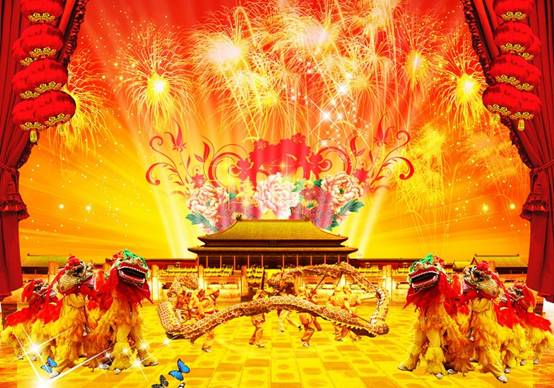
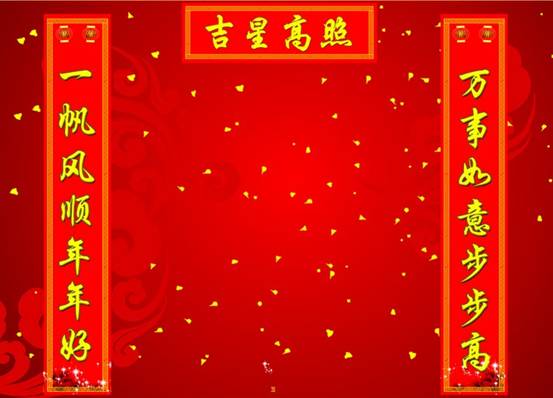
Lion dances, fireworks, family gathering, family meal, visiting friends and relatives (bàinián拜年), giving red envelopes, decorating with duilian ( duìlián对联).
3. Foods
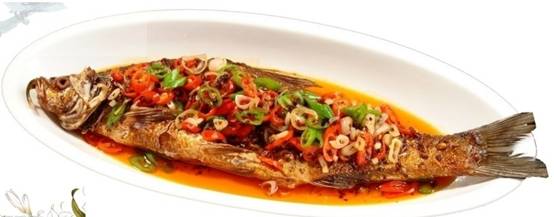
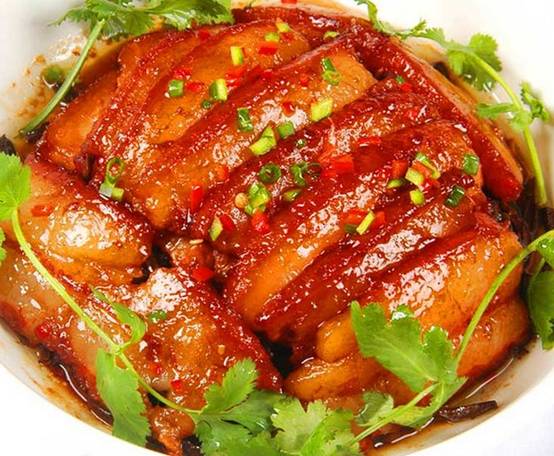
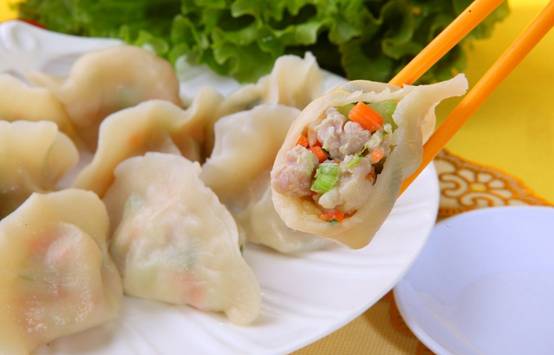
A reunion dinner, named as "Nian Ye Fan", is held on New Years Eve during which family members gather for celebration. The venue will usually be in or near the home of the most senior member of the family. The New Years Eve dinner is very large and sumptuous and traditionally includes dishes of meat (namely, pork and chicken) and fish. Most reunion dinners also feature a communal hot pot as it is believed to signify the coming together of the family members for the meal. Most reunion dinners (particularly in the Southern regions) also prominently feature specialty meats (e.g. wax-cured meats like duck and Chinese sausage) and seafood (e.g. lobster and abalone) that are usually reserved for this and other special occasions during the remainder of the year. In most areas, fish (traditional Chinese: 魚; simplified Chinese: 鱼; pinyin: yú) is included, but not eaten completely (and the remainder is stored overnight), as the Chinese phrase "may there be surpluses every year" (traditional Chinese: 年年有餘; simplified Chinese: 年年有余; pinyin: niánnián yǒu yú) sounds the same as "let there be fish every year."
An elaborate vegetarian dish served by Chinese families on the eve and the first day of the New Year. A type of black hair-like algae, pronounced "fat choy" in Cantonese, is also featured in the dish for its name, which sounds like "prosperity". Hakkas usually serve kiu nyuk (Chinese: 扣肉; pinyin: kòuròu) and ngiong teu fu.
Boiled chicken is served because it is figured that any family, no matter how humble their circumstances, can afford a chicken for Chinese New Year.
Is usually served in a dish with rondelles of Chinese sausage or waxed meat during Chinese New Year. The pronunciation of leek (蒜苗/大蒜Suàn miáo/Dà suàn) makes it a homophone for "calculating (money)" (算Suàn). The waxed meat is so chosen because it is traditionally the primary method for storing meat over the winter and the meat rondelles resemble coins.
The main Chinese new year dumpling. It is believed to resemble ancient Chinese gold ingots (traditional Chinese: 金元寶; simplified Chinese: 金元宝; pinyin: jīnyuánbǎo)
Eaten traditionally in northern China because the preparation is similar to packaging luck inside the dumpling, which is later eaten. The dumpling resembles a silver ingot, or money. The symbolism is prosperity.
Mandarin oranges are the most popular and most abundant fruit during Chinese New Year – jin ju (Chinese:金橘子; pinyin: jīnjúzi) translation: golden tangerine/orange or kam (Chinese: 柑; pinyin: gān) in Cantonese. Also, the name gik (橘 jú) in Teochew dialect is a homophone of "luck" or "fortune" (吉 jí).
Most popular in eastern China (Jiangsu, Zhejiang and Shanghai) because its pronunciation is a homophone for "a more prosperous year (年高 lit. year high)". Nian gao is also popular in the Philippines because of its large Chinese population and is known as "tikoy" (Chinese: 甜粿, from Min Nan) there. Known as Chinese New Year pudding, nian gao is made up of glutinous rice flour, wheat starch, salt, water, and sugar. The color of the sugar used determines the color of the pudding (white or brown).
Other variations include sunflower, pumpkin and other seeds. It symbolizes fertility and having many children.
4. Symbolism
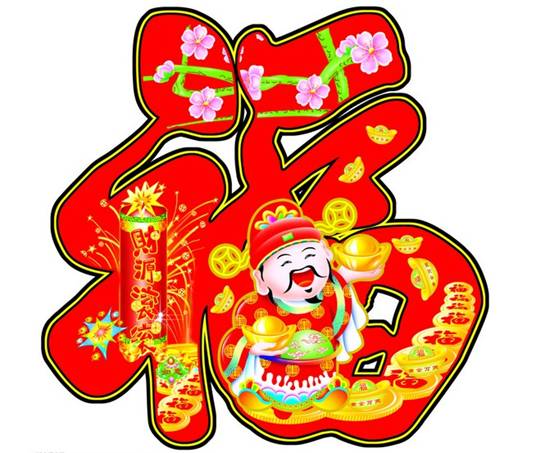
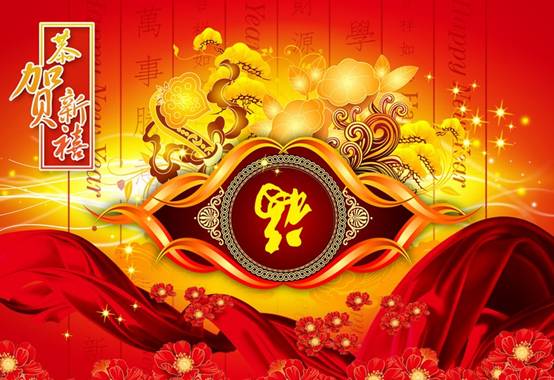
As with all cultures, Chinese New Year traditions incorporate elements that are symbolic of deeper meaning. One common example of Chinese New Year symbolism is the red diamond-shaped fú characters (Chinese: 福, Cantonese and Hakka: fook, literally "blessings, happiness"), which are displayed on the entrances of Chinese homes. This sign is usually seen hanging upside down, since the Chinese word 倒 (dào) "upside down", is homophonous or nearly homophonous with 到 (dào) "arrive" in all varieties of Chinese. Therefore, it symbolizes the arrival of luck, happiness, and prosperity.
For the Cantonese-speaking people, if the fook sign is hung upside down, the implied 倒 "upside down" sounds like the Cantonese word for "pour", producing "pour the luck [away]", which would usually symbolize bad luck; this is why the fook character is not usually hung upside-down in Cantonese communities.
Red is the predominant color used in New Year celebrations. Red is the emblem of joy, and this color also symbolizes virtue, truth and sincerity. On the Chinese opera stage, a painted red face usually denotes a sacred or loyal personage and sometimes a great emperor. Candies, cakes, decorations and many things associated with the New Year and its ceremonies are colored red. The sound of the Chinese word for “red” ( 紅, hóng) is “hong” in Mandarin (Hakka: Fung; Cantonese: Hoong) which also means “prosperous.” Therefore, red is an auspicious color and has an auspicious sound. |